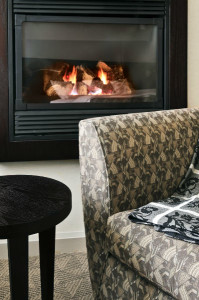Wood or Gas Fireplace?
Wood vs. Gas
If you find yourself always choosing the bed and breakfast room ‘with a fireplace’ and wishing you could take that experience home with you, don’t let not having a chimney stand in your way. Or, if you prefer pushing a button over hauling wood, building a fire, poking the fire, and then having a huge mess to clean up the next day—a gas fireplace insert may just be a consideration.
Choosing between a gas or wood fireplace can be a challenge—some homeowners prefer the authenticity and experience of the real thing—but considering some of the benefits of gas may help homeowners who are considering it as an option.
Gas fireplace inserts come in many varieties and options, and can be fitted into almost any fireplace, with or without an intact, working chimney. Advanced technology in the design of gas logs has resulted in better designs that can often be mistaken for the real thing, and without you ever having to lift a poker, sweep the hearth, or dump ashes.
Dangerous chemicals are released into the air when burning fuels, so both wood burning and vented gas inserts require a working chimney or other ventilation. Direct-vent or B-vent inserts are an intermediate option that vent through horizontal flues. Ventless inserts, however, are self-contained and do not need any external exhaust since they regulate themselves, reduce carbon emissions, and monitor oxygen levels.
Here are a few of the benefits of having a gas insert:
- Gas is less expensive and more efficient than wood or electricity
- Gas is less messy and burns more predictably than wood
- Easier
- No collecting firewood in the cold
It’s important to remember that with a vented gas insert, you will still need to have an annual chimney cleaning to remove debris that could catch fire in the chimney, as well as soot, carbon and dust.


